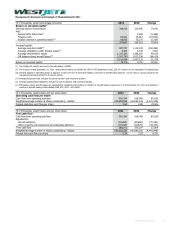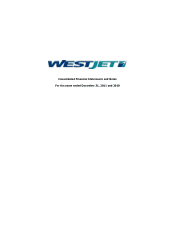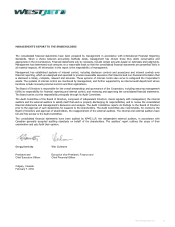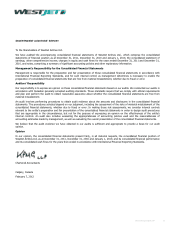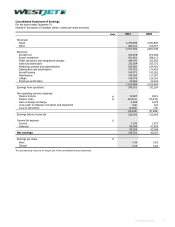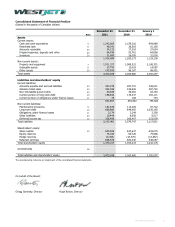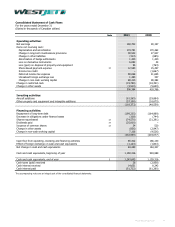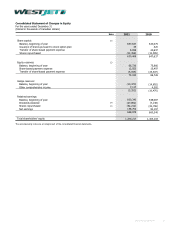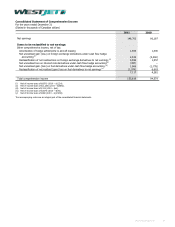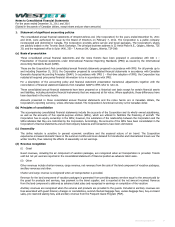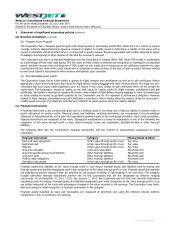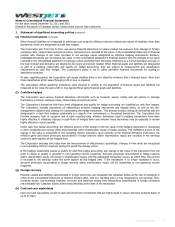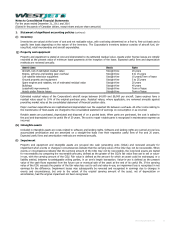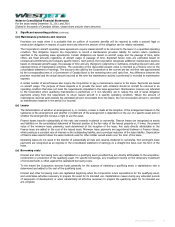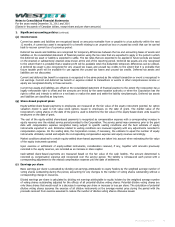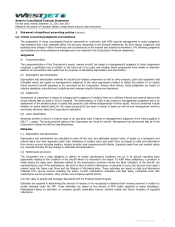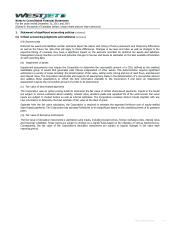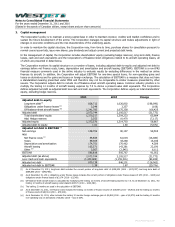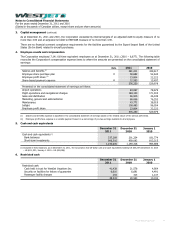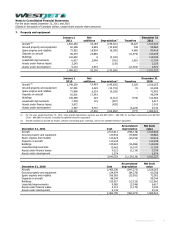Westjet 2011 Annual Report Download - page 70
Download and view the complete annual report
Please find page 70 of the 2011 Westjet annual report below. You can navigate through the pages in the report by either clicking on the pages listed below, or by using the keyword search tool below to find specific information within the annual report.
Notes to Consolidated Financial Statements
For the years ended December 31, 2011 and 2010
(Stated in thousands of Canadian dollars, except share and per share amounts)
│
1. Statement of significant accounting policies (continued)
(d) Revenue recognition (continued)
(iii) Frequent Guest Program
The Corporation has a frequent guest program that allows guests to accumulate credits that entitle them to a choice of various
rewards, primarily discounted travel. Revenue received in relation to credits issued is deferred as a liability at fair value until a
reward is ultimately utilized at which time it is recognized in guest revenue. Revenue associated with credits expected to expire
(breakage) is recognized in other revenue at the time the revenue is received.
The Corporation also has a co-branded MasterCard with the Royal Bank of Canada (RBC). RBC issues FGP credits to cardholders
as a percentage of their total retail spend. The fair value of these credits is deferred and recognized on redemption as described
above. Ancillary revenue from the issuance of FGP credits on the credit card is measured as the difference between the cash
received and the fair value of the credit issued and is recognized in other revenue at the time a credit is issued. Revenue related
to new cards issued is recognized in other revenue immediately upon activation.
(iv) Non-refundable guest credits
The Corporation issues future travel credits to guests for flight changes and cancellations as well as for gift certificates. Where
appropriate, future travel credits are also issued for flight delays, missing baggage and other inconveniences. All credits are non-
refundable and have expiry dates dependent upon the nature of the credit, except for gift certificates which do not contain an
expiry date. The Corporation records a liability at the face value for credits issued for flight changes, cancellations and gift
certificates. No liability is recorded at issuance for travel credits related to flight delays, missing baggage or other inconveniences
as these credits are issued as goodwill gestures by the Corporation and do not represent a performance obligation. Revenue
related to flight changes, cancellations and gift certificates is recorded in other revenue when the credit is utilized or upon expiry.
Credits issued as a sign of goodwill are recorded as a reduction to guest revenue when the credit is utilized.
(e) Financial instruments
A financial instrument is any contract that gives rise to a financial asset of one entity and a financial liability to another entity or
equity instrument of another entity. Financial assets and liabilities, including derivatives, are recognized in the consolidated
statement of financial position at the time the Corporation becomes a party to the contractual provisions. Upon initial recognition,
financial instruments are measured at fair value. Subsequent measurement is based on designation in one of the following five
categories: at fair value through profit or loss, held-to-maturity, loans and receivables, available-for-sale or other financial
liabilities.
The following table lists the Corporation’s financial instruments and the method of measurement subsequent to initial
recognition:
Financial instrument Category Measurement method
Cash and cash equivalents At fair value through profit or loss Fair value
Restricted cash At fair value through profit or loss Fair value
Deposits At fair value through profit or loss Fair value
Accounts receivable Loans and receivables Amortized cost
Accounts payable and accrued liabilities Other financial liabilities Amortized cost
Long-term debt Other financial liabilities Amortized cost
Finance lease obligations Other financial liabilities Amortized cost
Derivative instruments At fair value through profit or loss Fair value
Financial assets and liabilities at fair value through profit or loss include financial assets and liabilities held-for-trading and
financial assets and liabilities designated upon initial recognition at fair value through profit or loss. Financial assets and liabilities
are classified as held-for-trading if they are acquired for the purpose of selling or repurchasing in the near term. This category
includes derivative financial instruments entered into by the Corporation that are not designated as effective hedging
instruments. As at December 31, 2011, 2010, and January 1, 2010, the Corporation did not hold any financial instruments
classified as held-for-trading. Financial assets and liabilities designated upon initial recognition at fair value through profit or loss
are initially measured at fair value with subsequent changes in fair value recorded in net earnings. The Corporation uses trade-
date accounting for initial recognition of financial instruments in this category.
Financial assets classified as loans and receivables are measured at amortized cost using the effective interest method.
Impairment, if any, is recorded in net earnings.
WestJet Annual Report 2011 70


